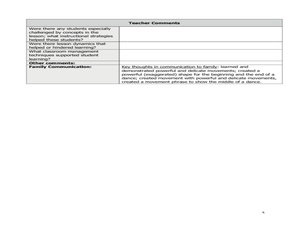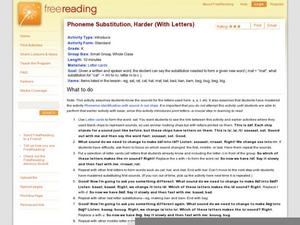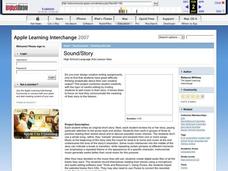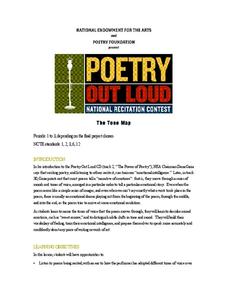Curated OER
Beginning and Ending Consonants
Young readers explore consonant sounds. In this beginning phonics lesson, learners fill in a beginning/middle/end vertical column chart with the sounds they hear in the pictured object. Practice spelling CVC words.
Curated OER
Dance and Writing
Fourth graders use dance moves to perform narratives. In this dramatic performing lesson, 4th graders use strong and soft movements to show what character's voice is portraying. Students also use movement to show the feelings in the...
Curated OER
Introduce Last Sound Segmenting (Mico Version)
What is Mico trying to say? Use a puppet to make this final-phoneme activity more engaging for kindergartners. Using three picture cards at a time (included), they listen to him say a final sound. To which of the three images is he...
Curated OER
Phoneme Segmenting Accuracy
Take your kindergartners on a journey to the mythical planet Paz where residents segment words into phonemes, touching parts of their arm with each sound. This physical response to phoneme segmenting will appeal to your physical learners...
Curated OER
Phoneme Substitution, Harder (With Letters)
Emergent readers create new words by changing a phoneme, using sets of letter cards to spell out each CVC word. They begin by substituting initial sounds, then final sounds, and lastly the middle vowel. Help them sound out each word,...
Indiana University
Literature of Asia and the Middle East: "A Sound of Hammering" by Dazai Osamu
Dazai Osamu’s short story, “A Sound of Hammering” is the focus of a three-day investigation of modern Japanese literature and life in post-World War II Japan. The events in Osamu’s story mirror those in his own life, and give a...
Curated OER
Create An Ending
Students create a new ending for a familiar story that stand alone with a clear beginning, middle and end. As a class, students review a familiar text focusing on plot and character development. In small groups, students work...
Curated OER
Drum Roll, Please!
Drill and practice phonemes, letter formations, written language, vowel correspondences, as well as consonant correspondences with youngsters. They will locate and identify the /b/ in written and spoken words from flash cards containing...
Curated OER
Phoneme Substitution (With Letters)
Get pre-readers comfortable with phoneme substitution using these helpful letter cards, which are printable in three different sizes depending on your classroom needs. Once scholars understand some letter sounds, they can begin...
Ken Baker
Phonemic Alliteration Lesson Plan
Old MacDonald had a ... dragon? A shared reading of this funny take on the classic children's song engages beginning readers as they learn about phonemes and alliteration.
Curated OER
Sound/Story
Young scholars combine creativity with the rigor of careful editing by adding music to their story. It forces them to focus on how they communicate the meaning of their story to the listener.
Curated OER
Always Allow Alliteration (part 1)
Students identify letters and sound that are being alliterated in a text they are given. In this alliteration worksheet, students also create alliteration in words and sentences.
Curated OER
Rosie's Roses Lesson Idea: Practice Hearing the R
Students focus on the sound of the letter /r/ after listening to Rosie's Roses by Pamela Duncan Edwards. In this letter /r/ lesson, students identify animals in the book that contain the /r/ sound. They sort /r/ words into groups by the...
Curated OER
Short A Words
Students study the short "a" sound. In this word study lesson, students brainstorm words that begin with a short "a" sound and are given a picture of the word. Students play an online game to reinforce the concepts taught.
Curated OER
Introduce -er
Students practice the letter sound -er. In this sound fluency lesson, students identify the two letters that make the sound and write them on the board. Students practice making the sound -er and begin to identify 12 other letter sound...
Curated OER
Seven Fat Cats
First graders listen to a read aloud of "Seven Fat Cats" matching rhyming, beginning, ending and vowel sounds.
Curated OER
The Tone Map
Poems are meant to be heard. Hearing a poem being read enriches one’s understanding of the tone and mood of the piece. Introduce your class to the sounds of poetry with a packet that not only details how to use poetry recordings in the...
Curated OER
Double Jeopardy-Homophones
Second graders identify homophones as words that sound alike but have different meanings. They, given a pair of homophones, are to explain the meanings of the words using gestures, role playing, or drawing a picture with their partner.
Curated OER
Israel
The class creates and performs a movement performance of the creation story found in the Jewish tradition. This lesson begins with the research of Israeli culture and culminates in a performance of the narrated creation story....
Hawaiʻi State Department of Education
Picture Poetry
What a fun idea! The class discusses, and then writes free-verse poems using sensory detail. They get into small collaborative writing teams to compose their poems. Next, they pantomime the actions from the poem while their teammates...
Curated OER
"HiSS"terical Snakes
Learners explore the /s/ sound on the end of words. They discuss the phoneme /s/. Students listen for /s/=s at the beginning, middle and end of words. They write the letter s and practice reading and writing words containing /s/.
Indiana University
World Literature: "One Evening in the Rainy Season" Shi Zhecun
Did you know that modern Chinese literature “grew from the psychoanalytical theory of Sigmund Freud”? Designed for a world literature class, seniors are introduced to “One Evening in the Rainy Season,” Shi Zhecun’s stream of...
Curated OER
Everyone Sang - Moods in Poetry
Start by reading the poem "Everyone Sang" by Siegried Sassoon. The archive also houses an audio clip, so consider playing that instead of reading it aloud. After hearing the poem twice, middle and high schoolers will discuss a list of...























